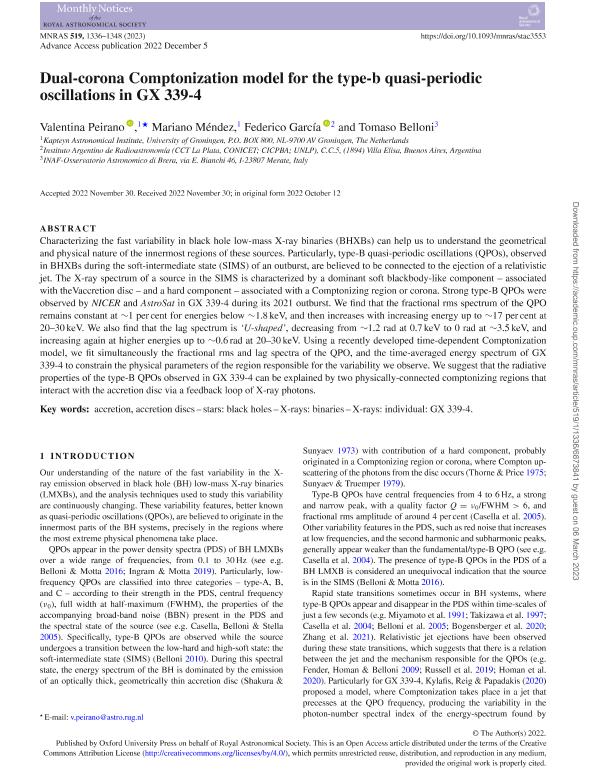Mostrar el registro sencillo del ítem
dc.contributor.author
Peirano, Valentina
dc.contributor.author
Mendez, Mariano

dc.contributor.author
García, Federico

dc.contributor.author
Belloni, Tomaso
dc.date.available
2023-11-14T12:17:17Z
dc.date.issued
2023-02
dc.identifier.citation
Peirano, Valentina; Mendez, Mariano; García, Federico; Belloni, Tomaso; Dual-corona Comptonization model for the type-b quasi-periodic oscillations in GX 339-4; Wiley Blackwell Publishing, Inc; Monthly Notices of the Royal Astronomical Society; 519; 1; 2-2023; 1336-1348
dc.identifier.issn
0035-8711
dc.identifier.uri
http://hdl.handle.net/11336/217986
dc.description.abstract
Characterizing the fast variability in black hole low-mass X-ray binaries (BHXBs) can help us to understand the geometrical and physical nature of the innermost regions of these sources. Particularly, type-B quasi-periodic oscillations (QPOs), observed in BHXBs during the soft-intermediate state (SIMS) of an outburst, are believed to be connected to the ejection of a relativistic jet. The X-ray spectrum of a source in the SIMS is characterized by a dominant soft blackbody-like component - associated with theVaccretion disc - and a hard component - associated with a Comptonizing region or corona. Strong type-B QPOs were observed by NICER and AstroSat in GX 339-4 during its 2021 outburst. We find that the fractional rms spectrum of the QPO remains constant at ~1 per cent for energies below ~1.8 keV, and then increases with increasing energy up to ~17 per cent at 20-30 keV. We also find that the lag spectrum is 'U-shaped', decreasing from ~1.2 rad at 0.7 keV to 0 rad at ~3.5 keV, and increasing again at higher energies up to ~0.6 rad at 20-30 keV. Using a recently developed time-dependent Comptonization model, we fit simultaneously the fractional rms and lag spectra of the QPO, and the time-averaged energy spectrum of GX 339-4 to constrain the physical parameters of the region responsible for the variability we observe. We suggest that the radiative properties of the type-B QPOs observed in GX 339-4 can be explained by two physically-connected comptonizing regions that interact with the accretion disc via a feedback loop of X-ray photons.
dc.format
application/pdf
dc.language.iso
eng
dc.publisher
Wiley Blackwell Publishing, Inc

dc.rights
info:eu-repo/semantics/openAccess
dc.rights.uri
https://creativecommons.org/licenses/by-nc-sa/2.5/ar/
dc.subject
ACCRETION, ACCRETION DISKS
dc.subject
STARS: BLACK HOLES
dc.subject
X-RAYS: BINARIES
dc.subject.classification
Astronomía

dc.subject.classification
Ciencias Físicas

dc.subject.classification
CIENCIAS NATURALES Y EXACTAS

dc.title
Dual-corona Comptonization model for the type-b quasi-periodic oscillations in GX 339-4
dc.type
info:eu-repo/semantics/article
dc.type
info:ar-repo/semantics/artículo
dc.type
info:eu-repo/semantics/publishedVersion
dc.date.updated
2023-11-13T15:54:43Z
dc.journal.volume
519
dc.journal.number
1
dc.journal.pagination
1336-1348
dc.journal.pais
Reino Unido

dc.description.fil
Fil: Peirano, Valentina. Kapteyn Astronomical Institute; Países Bajos
dc.description.fil
Fil: Mendez, Mariano. Kapteyn Astronomical Institute; Países Bajos
dc.description.fil
Fil: García, Federico. Provincia de Buenos Aires. Gobernación. Comisión de Investigaciones Científicas. Instituto Argentino de Radioastronomía. Consejo Nacional de Investigaciones Científicas y Técnicas. Centro Científico Tecnológico Conicet - La Plata. Instituto Argentino de Radioastronomía; Argentina
dc.description.fil
Fil: Belloni, Tomaso. Osservatorio Astronomico Di Brera; Italia
dc.journal.title
Monthly Notices of the Royal Astronomical Society

dc.relation.alternativeid
info:eu-repo/semantics/altIdentifier/url/https://academic.oup.com/mnras/article/519/1/1336/6873841
dc.relation.alternativeid
info:eu-repo/semantics/altIdentifier/doi/http://dx.doi.org/10.1093/mnras/stac3553
Archivos asociados
